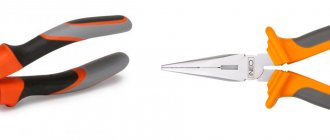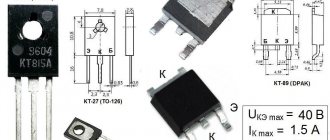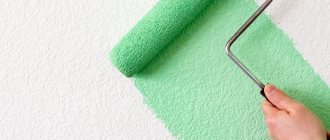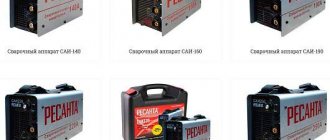One of the most common tools for applying paint is a paint roller.
However, coloring is far from the only area of its application, and to solve each problem, its corresponding type is selected, of which there are more than a dozen.
The tools have different coatings on the working part, sizes and shapes, and include special types.
At the same time, the characteristics of the surface being processed, the material being applied and the conditions of use completely determine which roller to choose for specific tasks.
Further on, what is this tool for, what are its advantages, features, main types and their estimated cost.
Purpose and operating principle of rollers
The purpose of the roller depends on its coat, which is discussed in more detail below.
This is how, in fact, the main division into types is carried out, for example:
- Paint rollers - used for applying various paint coatings.
The roller coat absorbs the paint, after which painting is performed by rolling the rotating part (roller) over the surface to be treated. - Models for plastering - to create texture on a freshly plastered surface.
In other words, on the working part of the roller there is a three-dimensional pattern that pushes through the top layer of plaster or any other material with similar parameters, leaving an imprint. - Options for self-leveling floors - used to remove air from a newly poured solution.
Peculiarities
The roller is a hand tool consisting of a yoke (curved part), a tube (metal part), and a reel (rotating cylinder). Thanks to its simple design, it is easy to work with. The scope of use is huge: applying paint, glue, primer, expelling air from under the wallpaper, forming a pattern on the surface if the roller is shaped.
The versatility of the tool is amazing. Moreover, if you use an additional handle. It allows you, while working below, to reach the ceiling and process hard-to-reach places. Among the advantages are ergonomics, ease of use, accurate application of the material to the surface, and uniformity of this application. Thanks to the different widths of the working base, the process of applying glue is carried out quickly and efficiently. But that's not all you need to know about the roller. After all, it is suitable not only for applying wallpaper glue.
Device and characteristics
The design of the roller, regardless of its purpose, includes two main elements:
- The machine consists of a clasp and a handle. The first is a metal base on which the working part is attached. The entire structure is made in the form of a curved rod with a handle for holding.
- Working part. In most cases, this is a roller (reel) in the form of a tube made of plastic, on top of which a coating of various materials is applied, depending on the purpose. The working surface is called a fur coat.
Construction stores sell both assembled rollers and in the form of component parts: a roller with a fur coat and a clasp.
The latter option is preferable for large-scale work, since when the coat wears out, you can save money by purchasing only a replacement element and installing it on the clasp.
Dimensions and weight
Rollers are divided into the following types according to the width and diameter of the working cylinder:
- Mini roller – up to 150 mm and about 15 mm, respectively. Suitable for processing small areas, surfaces with complex terrain or places that are difficult to reach.
- Midi roller – 150 – 250 mm and 50 – 90 mm, respectively. A universal size, which is suitable for most jobs, including painting smooth or slightly embossed surfaces, leveling wallpaper when pasting.
- Maxi-roller – more than 250 mm and more than 80 mm, respectively. The work requires certain skills, since the tool belongs to the professional class. It is used when carrying out facade work, especially if the texture of the surface being treated has many irregularities.
Additional roller sizes include:
- Rod diameter (inner diameter of the cylinder). For most models it is 6 or 8 mm.
- The length of the handle also varies, and in accordance with this parameter, the rollers can be divided into: short - up to 350 mm, medium - from 350 to 450 mm, long - more than 500 mm. If necessary, you can purchase a special extension cord, which, in turn, can be telescopic.
In this case, the increase in the length of the roller can be 70–400 cm. - Weight – 100 – 300 g depending on the material and length of the handle. For rolling models, handle extensions are used, the weight of which can exceed 1 kg.
NOTE:
The given divisions of rollers into subtypes by size are purely arbitrary, and each manufacturer is independently able to classify their products based on personal preferences.
Another characteristic is the length of the pile.
For each fur coat material it is individual.
In addition, a fleecy coating is usually called a fur coat, and a bobbin with a lint-free coating is simply called a roller.
Criterias of choice
When choosing a roller, first of all, you should decide on its size. The larger the area of the ceiling to be decorated, the wider the roller needed. But in this matter it is important to maintain a balance, because a drum that is too large will become very heavy when applying paint, which will significantly complicate the process of treating the ceiling.
In addition, rollers with a long core are absolutely not suitable for multi-level ceiling structures. For such ceilings, it is better to use small and medium-sized painting tools.
The upholstery is selected based on the type of paint material that will cover the ceiling:
- If you purchased acrylic paint to paint the ceiling, it is better to choose a roller with a foam or nylon coating.
- For paints that contain synthetic resins, painters recommend purchasing rollers with short artificial bristles.
- When working with water-based paint, it is preferable to use rollers lined with sheepskin or velor. Such a coat will leave a beautiful, even layer of paint on the surface without smudges or poorly painted areas.
When painting ceilings, it is better to choose rollers with short or medium pile, which captures a sufficient amount of paint and does not produce strong splashes when scrolling. It should be taken into account that for porous substrates, it is preferable to use tools with elongated bristles, which are capable of painting the surface throughout its entire depth.
If repair work involves painting large areas, it is advisable to purchase rollers with a removable coat, which can be replaced with a new one if necessary.
Particular attention should be paid to the length of the roller handle and the material from which it is made. It is inconvenient to paint the ceiling with a tool equipped with a short clasp, so you need to take care of a special extension cord or purchase a stepladder in advance.
It is worth noting that the long plastic handle may not withstand the weight of a fur coat dipped in paint and may break during the work. To avoid such situations, choose painting tools with a metal tube handle.
Types of rollers and fur coats
According to the domestic classification, paint rollers are divided into:
- VMP – fur nozzle for painting floors.
- VP is a foam nozzle designed for water-based adhesive compositions.
- VMU – natural fur. The product is intended for painting corners.
- VM – fur covering.
According to the classification of foreign manufacturers, rollers are:
- PE – polyester based
- N – based on natural material
- PC – from polyacrylic modifications
- PA – from varieties of polyamides
So, depending on the material of the working surface, the roller coat is:
- Polyamide - made of artificial fiber with increased wear resistance to abrasion and chemical attack.
The main purpose is the application of water-dispersion paints. The length of the pile is 8 - 20 mm, and the longer it is, the easier it is to apply the coating to a rough surface. - Polyacrylic (acrylic) – has a dense pile, which reduces paint splashing during operation. Made from polyacrylonitrile, which is a synthetic fiber reminiscent of wool, and in most respects it is the same as the previous version.
Attention!
It is not intended for working with materials with aggressive components, which means it is suitable for applying water-based paints.
- Polyester - polyester, reminiscent of padding polyester. Extremely cheap to produce, has excellent absorption and retention properties.
When working on the surface being treated, it does not leave lint. The advantages are compensated by low mechanical resistance and the same durability. - Fur is a generalized name for two types of fur coats. Thus, the option made from natural fur is made from sheep wool and is suitable for treating any surface with varnishes, enamels, water-dispersion, and oil paints.
NOTE:
Not recommended for use with lime-based compounds.
Options made of faux fur - vestan, are used for applying any type of paint, and therefore are universal.
- Velor - plush pile is supported by a fabric base.
Suitable for finishing work on smooth surfaces. Tolerates solvents well. - Foam rubber. It is used for applying water-based varnishes, as well as water-dispersion paints. Essentially, this is polyurethane, which, among its other technical characteristics, has a density, the indicator of which is directly dependent on its service life.
The fur coat does not cake and quickly restores its original shape. The fibers are arranged in such a way that during operation they leave small air bubbles, which means an uneven final surface. - Flock is a textile base with glued polyurethane fiber. Features include strength, environmental friendliness of the material, and water resistance.
- Nylon is a representative of polyamide, which means it has the same properties.
- Felt is an environmentally friendly soft fur coat, suitable for various types of surfaces.
Felt copes well with paints based on aggressive solvents. - Thread - a roller made of fluffed nylon or polyacrylic thread, another name for a thread coat. Designed to work with water-based and oil-based paints.
- Rubber - most often the pressure roller is designed to expel air and increase adhesion when gluing wallpaper.
- Made of microfiber - suitable for working with antiseptics, impregnations, primers, glazes, as well as water-based paints. Microfiber has good absorbency and impact; it is used when processing both completely smooth surfaces and those with slight roughness.
They also use silicone coats for applying decorative patterns and leather coats for working with Venetian plaster.
Latex paints require a synthetic coat.
As for the rollers, the most common materials used are plastic and aluminum, and less commonly, wooden ones.
Rollers with plastic rollers are generally the cheapest due to their ease of manufacture.
It should be noted that the roller may have a connecting seam or be seamless.
The latter option is preferable, since otherwise the movement of the roller along the surface to be treated is hampered at the seam site, which leads to disruption of the uniformity of the applied paint layer.
The presence of a seam is also eliminated by the so-called circular knitted base of the fur coat with a uniform layer of roller coating.
Fastening fur coats
Depending on the type of attachment of the fur coat to the roller, the tool can be:
- Glued – with a non-removable working surface. A narrow strip of fur coat is wrapped around the base with glue applied, forming a joint joint to joint. This type of fur coat fastening system is seamless, since the seam runs in a spiral, which means that the paint is applied evenly during operation.
- Thermo-glued - the fur coat is soldered into a cylindrical base. The design is more durable and reliable due to the absence of glue.
- Sewn - rectangular fabric sewn to fit the shape of a sleeve.
- With a replaceable coat.
In the latter case, a quick-release system of one of the options is used to attach the fur coat:
– Rod (clasp) – a monolithic handle with a rod onto which a roller with a rotation and fixation device mounted inside is placed. The simplest option.
– Frame – the fur coat is fixed on a roller made in the form of a hollow cylinder-frame. The clasp contains bearings on which the equipment is installed. That's why this tool is called a frame roller.
There is also a so-called special fastening system, implemented on long rollers.
The rectangular frame has an axis secured by means of a thread, onto which a roller with end bushings is mounted.
How to choose the length of the pile
The length of the roller pile determines the amount of paint it can absorb and, accordingly, the thickness of the applied paint layer. Long pile has thicker threads, short pile has thinner threads. The choice of pile length depends on the texture of the walls being painted.
- For a rough surface - putty, concrete, wood - a fur coat with a pile of medium length - 5-20 mm - is best suited.
USEFUL INFORMATION: How to choose wallpaper for the living room: interior design
- For smooth walls made of metal, plastic or plasterboard, you will need a fur coat with a pile length of up to 5 mm;
- Large-relief surfaces, for example, those covered with textured plaster, are painted with a tool with a pile length exceeding 20 mm.
Types of rollers and their prices
Each construction roller can be classified into one of the following types:
- Painting – used for applying paint and varnish coating. The price depends on the material of the fur coat, ranging from 100 to 1200 rubles and above.
- Special – for performing other tasks.
The first option, depending on the fur coat or the design of the clasp, can be:
Universal
Suitable for working with any flat surfaces, including ceilings and walls, capable of applying enamels, varnishes and paints.
For working with specific compositions, for example, exclusively for applying water-based paints.
Radiator
Roller on a wire extended handle with a thin roller.
Purpose – painting the back surfaces of pipes and radiators, where it is impossible to reach with a regular clasp roller.
The cheapest one will cost 50 rubles.
Facade
Its characteristic feature is the large diameter of the roller, which increases the working surface area, a long handle, and most importantly, the presence in the design of a bearing that slows down rotation at high speeds.
As a rule, such a roller has a longer pile, and in combination with other characteristics, it increases the convenience and speed of processing surfaces with a large area.
Facade tools are often produced with a telescopic handle, which largely distinguishes them from models for interior work.
Price – from 200 rubles.
Angular
It has a small width roller that resembles a wheel, which allows you to easily paint corners and similar hard-to-reach places.
Price – from 130 rubles.
Special rollers include the following options:
Pressing (smooth)
They are used for applying adhesives, but mostly to remove air bubbles from under the material, mainly wallpaper.
This type of wallpaper roller has a rubber or polyurethane roller coating, also called a rolling roller.
The tool comes with a conical roller or a “barrel” shape.
At the same time, the rollers for wallpaper and for wallpaper seams are different.
Price – from 70 rubles.
Needle
There are several types of tools depending on their purpose.
For example, a drywall roller has sharp spikes on the working surface, which pierce the surface when rolled.
This is done so that the inner layer is better saturated with moisture for the subsequent giving of a certain shape to the sheet, say, under an arch.
Options for self-leveling floors can be studded with soft needles designed to remove air bubbles from the thickness of the poured material.
Price – from 200 rubles.
Textured
The general name for rollers for forming textured surfaces.
Thus, a structural tool has a coat that gives plastered and putty surfaces (in principle, from any structural composition) a decorative texture.
Another name is decorative roller.
Paneled (patterned)
It is quite rare on sale, and its purpose is decorative painting, excluding the use of a stencil.
This painting tool is designed for applying paneling.
The frame type of construction allows you to install a roller with any pattern of interest.
In addition to the classic mechanical rollers, which periodically have to be dipped into a tray of paint, there are options with a refill function.
They are designed to work with liquid water-based compositions, and the roller design has a side cover that locks the internal cavity into which paint is poured.
On the one hand, such a roller is convenient to use, on the other hand, it is disposable, since even if you rinse it well after use, the next time you use it, the paint will no longer appear on the fur coat with its original effectiveness.
Tips for the novice painter
- Do not use a roller that is too large. On the one hand, this way you will cover a large surface area with one movement, but on the other hand, such a roller is extremely impractical to use. As a result, the surface may turn out to be unevenly painted.
- To avoid drips and achieve a uniform color, thoroughly saturate the tool with paint using a special tray surface. If you don’t have it at hand, you can use a perforated metal sheet. As a last resort, cardboard will do.
- If it becomes necessary to use a tool for a composition whose color is different from the previous one, you should completely get rid of the old composition. First, you need to finish painting the element being processed, and then carefully roll the roller over a sheet of cardboard or plywood. This must be done until the tool stops leaving marks on the surface and all inclusions in its coat disappear. Then you can saturate the roller with new paint and continue working.
- The same product should not be used to transfer different types of paint and varnish compositions onto a plane. Even if the instrument visually looks clean and perfectly washed, it simply may not be suitable for using another substance.
- If painting work occurs intermittently, and there is a need to leave the tool for a while, you should wrap it tightly in a plastic bag and tie it tightly.
- If there is a need for long-term storage of the roller, then it is better to place it in some container of a suitable size, fill it with paint and wrap it tightly in a plastic bag.
Healthy? Save it to your wall! Thank you for like!
Tweet
Which roller should you choose?
In most cases, a medium-sized roller is suitable for use at home, especially if the master does not have decent experience in performing painting work.
For cosmetic repairs, a tool with a foam working surface will do.
Due to its low cost, it is not a pity to throw it away, and in the process of coloring it has repeatedly proven its sufficient effectiveness.
Important!
The length of the pile, as well as the material of the fur coat itself, is selected based solely on the paint used.
High quality coating is provided by a roller with a velor coat.
For professional work, it is better to buy several rollers of different sizes with replaceable coats.
This will allow you to take from existing tools the optimal width to complete the task without unnecessary trips to the hardware store.
Sometimes a paint roller is used to paint a car.
This method of applying paint is advisable solely from the point of view of economy if it is necessary to restore the coating of a vehicle intended for some off-road walking.
Extremely low quality of work is guaranteed even if an experienced painter with the most sophisticated roller gets to work.
To apply paintwork to the car body, you should use a tool designed for this purpose - a spray gun.
Additional tools
To make working with the roller as comfortable as possible, you should acquire additional tools. The most popular of them is the pallet. Nowadays you can even find sets of a pallet and a roller on sale.
Pallet for paint roller
Roller stands and cleaning tools can also be found. The tray is convenient because you can pour a fairly large amount of substance into it, and then evenly saturate the roller with it, rolling it along a special plane.
Return to content
What you need to know about rollers?
Each roller manufacturer names the material used to make the fur coat differently.
For example, foam rubber is moltoprene, or polyester is polyester. Moreover, instruments made from the same material sometimes have completely different colors, indicating quality.
Polyacrylic options similar to lamb fur are available in blue, yellow and light green (indicated in ascending order of quality).
The same foam rubber can be thick yellow and dark blue.
Attention!
The quality of the final result of painting work is influenced not only by the roller, but also by the paints used.
When choosing the latter, special attention should be paid to such properties as coverage (coverability, concealability) and consumption.











